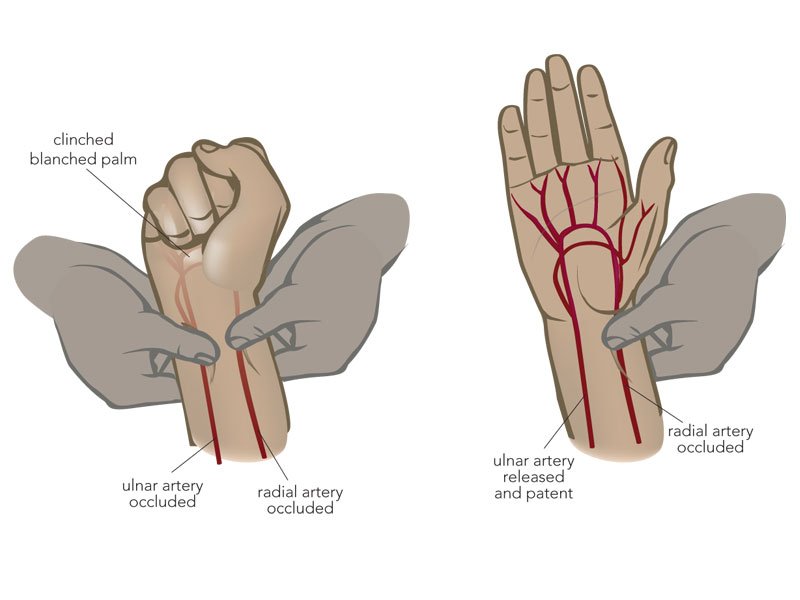The Allen Test for Blood Flow:
- This Allen test is first described in 1929 by Edgar V. Allen.
- it is a non-invasive evaluation of the arterial patency of the hand in patients with thromboangitis obliterans.
- This Allen test has since been adapted as to Modified Allen test = MAT.
- In the normal Allen’s test, both hands are tested simultaneously by the examiner [ therapist ] which is compressing the one artery of each hand at the same time.
- The MAT = Modified Allen test efficiently evaluates the adequacy of the circulation of collateral but it requires the testing of one hand at a time.
- This Allen test is a first-line standard test that is used to assess the arterial blood supply of the hand.
- This Allen test is performed whenever intravascular access to the radial artery is planned/for selecting the patients for the radial artery harvesting, like as for the coronary artery = bypass grafting/for forearm of flap elevation.
- This Allen test is part of to diagnostic work-up for the vascular abnormalities in the upper limb like in the thoracic outlet syndrome = TOS.
- In thoracic outlet syndrome = TOS & specifically vascular of thoracic outlet syndrome = TOS so that one possible cause is that the compression of the subclavian artery/vein as it passes through the inter scalene triangle by to muscle bodies at the scalene muscle which is available to muscular hypertrophy.
Clinically Relevant Anatomy of the hand:
- The hand is a complex & rich vascular network, which is most of the supplied by the radial & ulnar arteries.
- The radial artery runs between the brachioradialis & flexor carpi radialis muscles of the forearm & at the wrist joint splits into a superficial branch for to contribute to the superficial palmar arch.
- The other branch of the radial artery is crossed dorsally to deep into the tendons of the anatomic snuffbox to form the deep palmar arch.
- The ulnar artery is lies under the flexor carpi ulnaris of the forearm & at the wrist joint enters the Guyon’s canal, where it is split into a deep palmar branch & a superficial palmar branch.
- The superficial palmar branch forms the superficial palmar arch, while the deep branch contributes to the deep palmar arch.
- Since the radial & ulnar arteries both form the anastomosis means the deep & superficial palmar arch which is the blood supply of the hand is ensured to one of the arteries is occluded.
What is the purpose of the Allen Test for Blood Flow?
- This Allen Test is used to determine the patency of the radial & ulnar arteries.
- This Allen test is also used to determine which artery provides the major blood supply to the hand.
What is the technique of the Allen Test for Blood Flow?

- The patient is in the sitting position for the Allen test.
- The examiner [ therapist ] is asked to open & close the hand several times as quickly as possible & then squeeze the hand tightly.
- The examiner’s thumb & index finger are placed over the radial & ulnar arteries, compressing them.
- As an alternative technique, the examiner [ therapist ] may use both hands, placing one thumb over each artery to compress the artery & placing the fingers on the posterior aspect of the arm for stability.
- The patient then opens the hand while pressure is maintained over the arteries.
- One artery is tested by releasing the pressure over that artery to see if the hand flushes.
- The other artery is then tested similarly.
- Both hands should be tested for comparison.
- This test determines the patency of the radial & ulnar arteries & determine which artery provides the major blood supply to the hand.
Diagnostic Values & Interpretation of the Allen Test for Blood Flow:
- During the Allen test, digital compression of both ulnar & radial arteries which is at the level of the proximal wrist joint for crease is applied, which is causes the palmar blanching followed by the release of compression on any artery, which is also causing the hypermedia in the non-diseased state.
- Adequate collateral circulation is indicated by a return of the color to the hand within an adequate period.
- The sensitivity of the Allen Test = 54.5%
- The specificity of the Allen Test = 91.7%
- Diagnostic accuracy of the Allen Test = 78.5%.
- This result is at the cut – of 6 seconds.
- Diagnostic accuracy of the Allen Test = maximal – 79.6%,
- Sensitivity of the Allen Test = 75.8%
- Specificity of the Allen Test = 81.7%;
- This result is at the cut – off 5 seconds.
- Sensitivity of the Allen Test = 100%
- Specificity of the Allen Test = 27 %
- Diagnostic accuracy of the Allen Test = 52%
- This result is at the cut – of 3 seconds.








2 Comments